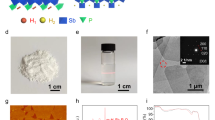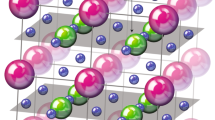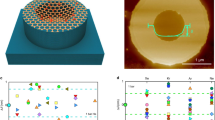Abstract
Understanding ‘electro–chemo–mechanics’ in oxygen ion conducting membranes represents a foundational step towards new energy devices such as micro fuel cells and oxygen or fuel separation membranes. For ionic transport in macro crystalline electrolytes, doping is conventionally used to affect oxygen ionic association/migration energies. Recently, tuning ionic transport in films through lattice strain conveyed by substrates or heterostructures has generated much interest. However, reliable manipulation of strain states to twist the ionic conduction in real micro energy devices remains intractable. Here, we demonstrate that the oxygen ionic conductivity clearly correlates with the compressive strain energy acting on the near order of the electrolyte lattices by comparing thin-film ceria-based membrane devices against substrate-supported flat structures. It is possible to capitalize on this phenomenon with a smart choice of strain patterns achieved through microelectrode design. We highlight the importance of electro–chemo–mechanics in the electrolyte material for the next generation of solid-state energy conversion microdevices.
This is a preview of subscription content, access via your institution
Access options
Subscribe to this journal
Receive 12 print issues and online access
$259.00 per year
only $21.58 per issue
Buy this article
- Purchase on Springer Link
- Instant access to full article PDF
Prices may be subject to local taxes which are calculated during checkout




Similar content being viewed by others
References
Evans, A., Bieberle-Hütter, A., Rupp, J. L. M. & Gauckler, L. J. Review on microfabricated micro-solid oxide fuel cell membranes. J. Power Sources 194, 119–129 (2009).
Evans, A. et al. Micro-solid oxide fuel cells: Status, challenges, and chances. Monatsh. Chem. 140, 975–983 (2009).
Garbayo, I. et al. Full ceramic micro solid oxide fuel cells: Towards more reliable MEMS power generators operating at high temperatures. Energy Environ. Sci. 7, 3617–3629 (2014).
Wachsman, E., Ishihara, T. & Kilner, J. Low-temperature solid-oxide fuel cells. MRS Bull. 39, 773–779 (2014).
Oudenhoven, J. F. M., Baggetto, L. & Notten, P. H. L. All-solid-state lithium-ion microbatteries: A review of various three-dimensional concepts. Adv. Energy Mater. 1, 10–33 (2011).
Waser, R., Dittmann, R., Staikov, G. & Szot, K. Redox-based resistive switching memories - nanoionic mechanisms, prospects, and challenges. Adv. Mater. 21, 2632–2663 (2009).
Messerschmitt, F., Kubicek, M., Schweiger, S. & Rupp, J. L. M. Memristor kinetics and diffusion characteristics for mixed anionic-electronic SrTiO3−δ bits: The memristor-based cottrell analysis connecting material to device performance. Adv. Funct. Mater. 24, 7448–7460 (2014).
Rupp, J. L. M. Ionic diffusion as a matter of lattice-strain for electroceramic thin films. Solid State Ion. 207, 1–13 (2012).
Rupp, J. L. M. et al. Scalable oxygen-ion transport kinetics in metal-oxide films: Impact of thermally induced lattice compaction in acceptor doped ceria films. Adv. Funct. Mater. 24, 1562–1574 (2014).
Rupp, J. L. M., Scherrer, B., Schäuble, N. & Gauckler, L. J. Time-temperature-transformation (TTT) diagrams for crystallization of metal oxide thin films. Adv. Funct. Mater. 20, 2807–2814 (2010).
Evans, A. et al. Residual stress and buckling patterns of free-standing yttria-stabilized-zirconia membranes fabricated by pulsed laser deposition. Fuel Cells 12, 614–623 (2012).
Kerman, K., Xuza, S. & Ramanathan, S. Free standing yttria-doped zirconia membranes: Geometrical effects on stability. J. Electroceramics 34, 91–99 (2015).
Tuller, H. L. & Bishop, S. R. Point defects in oxides: Tailoring materials through defect engineering. Annu. Rev. Mater. Res. 41, 369–398 (2011).
Yildiz, B. “Stretching” the energy landscape of oxides—effects on electrocatalysis and diffusion. MRS Bull. 39, 147–156 (2014).
Schweiger, S., Kubicek, M., Messerschmitt, F., Murer, C. & Rupp, J. L. M. A micro-dot multilayer oxide device: Let’s tune the strain-ionic transport interaction. ACS Nano 8, 5032–5048 (2014).
Schichtel, N., Korte, C., Hesse, D. & Janek, J. Elastic strain at interfaces and its influence on ionic conductivity in nanoscaled solid electrolyte thin films—theoretical considerations and experimental studies. Phys. Chem. Chem. Phys. 11, 3043–3048 (2009).
Tsvetkov, N., Lu, Q., Chen, Y. & Yildiz, B. Accelerated oxygen exchange kinetics on Nd2NiO4+δ thin films with tensile strain along c-axis. ACS Nano 9, 1613–1621 (2015).
Sillassen, M. et al. Low-temperature superionic conductivity in strained yttria-stabilized zirconia. Adv. Funct. Mater. 20, 2071–2076 (2010).
MohanKant, K., Esposito, V. & Pryds, N. Strain induced ionic conductivity enhancement in epitaxial Ce0.9Gd0.1O2−δ thin films. Appl. Phys. Lett. 100, 033105 (2012).
Garcia-Barriocanal, J. et al. Colossal ionic conductivity at interfaces of epitaxial ZrO2:Y2O3/SrTiO3 heterostructures. Science 321, 676–680 (2008).
Korte, C. et al. Coherency strain and its effect on ionic conductivity and diffusion in solid electrolytes—an improved model for nanocrystalline thin films and a review of experimental data. Phys. Chem. Chem. Phys. 16, 24575–24591 (2014).
Hinterberg, J., Zacherle, T. & De Souza, R. A. Activation volume tensor for oxygen-vacancy migration in strained CeO2 electrolytes. Phys. Rev. Lett. 110, 205901 (2013).
De Souza, R. A., Ramadan, A. & Hörner, S. Modifying the barriers for oxygen-vacancy migration in fluorite-structured CeO2 electrolytes through strain: A computer simulation study. Energy Environ. Sci 5, 5445–5453 (2012).
Shen, W., Jiang, J. & Hertz, J. L. Reduced ionic conductivity in biaxially compressed ceria. RSC Adv. 4, 21625–21630 (2014).
Schichtel, N. et al. On the influence of strain on ion transport: Microstructure and ionic conductivity of nanoscale YSZ—Sc2O3 multilayers. Phys. Chem. Chem. Phys. 12, 14596–14608 (2010).
Shen, W., Jiang, J. & Hertz, J. L. Beneficial lattice strain in heterogeneously doped ceria. J. Phys. Chem. C 118, 22904–22912 (2014).
Huang, H. et al. High-performance ultrathin solid oxide fuel cells for low-temperature operation. J. Electrochem. Soc. 154, B20–B24 (2007).
Bieberle-Hütter, A., Reinhard, P., Rupp, J. L. M. & Gauckler, L. J. The impact of etching during microfabrication on the microstructure and the electrical conductivity of gadolinia-doped ceria thin films. J. Power Sources 196, 6070–6078 (2011).
Rupp, J. L. M., Muecke, U. P., Nalam, P. C. & Gauckler, L. J. Wet-etching of precipitation-based thin film microstructures for micro-solid oxide fuel cells. J. Power Sources 195, 2669–2676 (2010).
Kerman, K., Tallinen, T., Ramanathan, S. & Mahadevan, L. Elastic configurations of self-supported oxide membranes for fuel cells. J. Power Sources 222, 359–366 (2013).
Garbayo, I. et al. Electrical characterization of thermomechanically stable YSZ membranes for micro solid oxide fuel cells applications. Solid State Ion. 181, 322–331 (2010).
Safa, Y., Hocker, T., Prestat, M. & Evans, A. Post-buckling design of thin-film electrolytes in micro-solid oxide fuel cells. J. Power Sources 250, 332–342 (2014).
Greenberg, B. M., Wachtel, E., Lubomirsky, I., Fleig, J. & Maier, J. Elasticity of solids with a large concentration of point defects. Adv. Funct. Mater. 16, 48–52 (2006).
Lubomirsky, I. Stress adaptation in ceramic thin films. Phys. Chem. Chem. Phys. 9, 3701–3710 (2007).
Lubomirsky, I. Practical applications of the chemical strain effect in ionic and mixed conductors. Monatsh. Chem. 140, 1025–1030 (2009).
Marrocchelli, D., Bishop, S. R., Tuller, H. L. & Yildiz, B. Understanding chemical expansion in non-stoichiometric oxides: Ceria and zirconia case studies. Adv. Funct. Mater. 22, 1958–1965 (2012).
Davis, L. Investigation of Residual and Thermal Stress on Membrane-Based MEMS Devices (Univ. South Florida, 2009); http://scholarcommons.usf.edu/etd/1925
Baertsch, C. et al. Fabrication and structural characterization of self-supporting electrolyte membranes for a micro solid-oxide fuel cell. J. Mater. Res. 19, 2604–2615 (2004).
Timoshenko, S. P. Theory of Elastic Stability (Dover, 2009).
Kossoy, A. et al. Influence of point-defect reaction kinetics on the lattice parameter of Ce0.8Gd0.2O1.9 . Adv. Funct. Mater. 19, 634–641 (2009).
Anjaneya, K. C., Nayaka, G. P., Manjanna, J., Govindaraj, G. & Ganesha, K. N. Preparation and characterization of Ce1−xGdxO2−δ (x = 0.1–0.3) as solid electrolyte for intermediate temperature SOFC. J. Alloys Compd. 578, 53–59 (2013).
Mogensen, M., Sammes, N. & Tompsett, G. Physical, chemical and electrochemical properties of pure and doped ceria. Solid State Ion. 129, 63–94 (2000).
Giannici, F. et al. Structure and oxide ion conductivity: Local order, defect interactions and grain boundary effects in acceptor-doped ceria. Chem. Mater. 26, 5994–6006 (2014).
Kourouklis, G. A., Jayaraman, A. & Espinosa, G. P. High-pressure Raman study of CeO2 to 35 GPa and pressure-induced phase transformation from the fluorite structure. Phys. Rev. B 37, 4250–4253 (1988).
Stoney, G. G. The tension of metallic films deposited by electrolysis. Proc. R. Soc. Lond. A 82, 172–175 (1909).
Feng, X., Huang, Y. & Rosakis, A. J. On the Stoney formula for a thin film/substrate system with nonuniform substrate thickness. J. Appl. Mech. 74, 1276–1281 (2007).
Yasuda, K., Uemura, K. & Shiota, T. Sintering and mechanical properties of gadolinium-doped ceria ceramics. J. Phys. Conf. Ser. 339, 012006 (2012).
Dolbow, J. & Gosz, M. Effect of out-of-plane properties of a polyimide film on the stress fields in microelectronic structures. Mech. Mater. 23, 311–321 (1996).
Acknowledgements
S. Li is thanked for support in carrying out parts of the electric measurements. N. Spencer, C. Crémmel, C. Schneider and T. Lippert are thanked for their assistance with analytical tools. The authors acknowledge P. Muralt for providing the Si3N4-coated Si wafers as substrate samples. M. Kubicek, M. Struzik, M. Rawlence and Z. Lapin are thanked for discussion and proof reading. This work was supported by the Swiss National Science Foundation under the project numbers of 144988, 147190 and 138914.
Author information
Authors and Affiliations
Contributions
Y.S. and S.S. performed and executed the experiments and J.L.M.R. discussed and supervised the work. A.H.B. carried out the computational analysis in collaboration with J.L.M.R. and Y.S. The paper was co-written by Y.S., A.H.B., S.S. and J.L.M.R., and all authors discussed the results and interpretations, and commented on the manuscript.
Corresponding author
Ethics declarations
Competing interests
The authors declare no competing financial interests.
Supplementary information
Supplementary Information
Supplementary Information (PDF 2498 kb)
Rights and permissions
About this article
Cite this article
Shi, Y., Bork, A., Schweiger, S. et al. The effect of mechanical twisting on oxygen ionic transport in solid-state energy conversion membranes. Nature Mater 14, 721–727 (2015). https://doi.org/10.1038/nmat4278
Received:
Accepted:
Published:
Issue Date:
DOI: https://doi.org/10.1038/nmat4278
This article is cited by
-
Mechanistic formulation of inorganic membranes at the air–liquid interface
Nature (2023)
-
CuO-based materials for thermochemical redox cycles: the influence of the formation of a CuO percolation network on oxygen release and oxidation kinetics
Discover Chemical Engineering (2022)
-
Enhanced low-temperature proton conductivity in hydrogen-intercalated brownmillerite oxide
Nature Energy (2022)
-
Lattice strain-enhanced exsolution of nanoparticles in thin films
Nature Communications (2019)
-
Accelerated Oxygen Mass Transfer in Copper and Vanadium Oxide-Based MIEC-Redox Membrane
Metallurgical and Materials Transactions B (2019)



